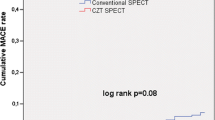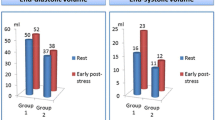Abstract
It has been advocated that using the stress followed by rest protocol, if the stress images were normal there is no need of rest images, reducing radiation exposure and costs. Our purpose was to assess the prognosis of a group of patients with normal stress-only gated-SPECT myocardial perfusion imaging. This was retrospective study that includes 790 patients with normal myocardial stressonly perfusion gated SPECT images. Images were considered as normal if a homogeneous myocardial distribution of the tracer was associated with a normal ejection fraction. The mean follow-up was of 42.8 ± 13.3 months. The considered events were death of all causes, myocardial infarction and myocardial revascularization. During this period there were 85 events (10.8 %), including 57 deaths of all causes (67.1 %), 9 myocardial infarctions (10.6 %), 19 revascularizations (2.4 %). In the first year of follow-up there were 32 events (4.0 %) and excluding non cardiac deaths there were 8 events (1.0 %). Using Cox survival analysis, diabetes (HR = 2.2; CI = 1.4–3.4; p ≤ 0.0005), the history of coronary artery disease (CAD) (HR = 2.1; CI = 1.3–3.2; p ≤ 0.001), age (HR = 1.0; CI = 1.0–1.0; p ≤ 0.05) and type of stress protocol were related with events (exercise test vs. adenosine) (Exercise test: HR = 0.5; CI = 0.3–0.8; p ≤ 0.01). In a multivariate analysis the independent predictors were diabetes, CAD and the type of stress protocol. Based on these results, normal stress-only images are associated with an excellent prognosis even in patients at higher risk, diabetics and patients with known CAD.



Similar content being viewed by others
References
Brown KA, Altland E, Rowen M (1994) Prognostic value of normal technetium-99m-sestamibi cardiac imaging. J Nucl Med 35:554
Hachamovitch R, Hayes S, Friedman JD et al (2003) Determinants of risk and its temporal variation in patients with normal stress myocardial perfusion scans: what is the warranty period of a normal scan? J Am Coll Cardiol 41:1329
Klocke FJ, Baird MG, Lorell BH et al (2003) ACC/AHA/ASNC guidelines for the clinical use of cardiac radionuclide imaging–executive summary: a report of the American College of Cardiology/American Heart Association Task Force on practice guidelines (ACC/AHA/ASNC Committee to Revise the 1995 guidelines for the clinical use of cardiac radionuclide imaging). J Am Coll Cardiol 42:1318
Gibson PB, Demus D, Noto R et al (2002) Low event rate for stress-only perfusion imaging in patients evaluated for chest pain. J Am Coll Cardiol 39:999
Einstein AJ, Moser KW, Thompson RC et al (2007) Radiation dose to patients from cardiac diagnostic imaging. Circulation 116:1290
Hachamovitch R, Berman DS, Shaw LJ et al (1998) Incremental prognostic value of myocardial perfusion single photon emission computed tomography for the prediction of cardiac death: differential stratification for risk of cardiac death and myocardial infarction. Circulation 97:535
Iskander S, Iskandrian AE (1998) Risk assessment using single-photon emission computed tomographic technetium-99m sestamibi imaging. J Am Coll Cardiol 32:57
Shaw LJ, Iskandrian AE (2004) Prognostic value of gated myocardial perfusion SPECT. J Nucl Cardiol 11:171
Schinkel AF, Boiten HJ, van der Sijde JN et al (2012) 15-Year outcome after normal exercise (9)(9)mTc-sestamibi myocardial perfusion imaging: what is the duration of low risk after a normal scan? J Nucl Cardiol 19:901
Chang SM, Nabi F, Xu J et al (2010) Normal stress-only versus standard stress/rest myocardial perfusion imaging: similar patient mortality with reduced radiation exposure. J Am Coll Cardiol 55:221
Duvall WL, Wijetunga MN, Klein TM et al (2010) The prognosis of a normal stress-only Tc-99m myocardial perfusion imaging study. J Nucl Cardiol 17:370
Mathur S, Heller GV, Bateman TM et al (2013) Clinical value of stress-only Tc-99m SPECT imaging: importance of attenuation correction. J Nucl Cardiol 20:27
Berman DS, Kang X, Slomka PJ et al (2007) Underestimation of extent of ischemia by gated SPECT myocardial perfusion imaging in patients with left main coronary artery disease. J Nucl Cardiol 14:521
Robinson VJ, Corley JH, Marks DS et al (2000) Causes of transient dilatation of the left ventricle during myocardial perfusion imaging. AJR Am J Roentgenol 174:1349
Hung GU, Lee KW, Chen CP et al (2005) Relationship of transient ischemic dilation in dipyridamole myocardial perfusion imaging and stress-induced changes of functional parameters evaluated by Tl-201 gated SPECT. J Nucl Cardiol 12:268
Ahlberg AW, Baghdasarian SB, Athar H et al (2008) Symptom-limited exercise combined with dipyridamole stress: prognostic value in assessment of known or suspected coronary artery disease by use of gated SPECT imaging. J Nucl Cardiol 15:42
Fleming RM, Harrington GM, Baqir R et al (2009) The evolution of nuclear cardiology takes us back to the beginning to develop today’s “new standard of care” for cardiac imaging: how quantifying regional radioactive counts at 5 and 60 min post-stress unmasks hidden ischemia. Methodist Debakey Cardiovasc J 5:42
Wackers FJ, Young LH, Inzucchi SE et al (2004) Detection of silent myocardial ischemia in asymptomatic diabetic subjects: the DIAD study. Diabetes Care 27:1954
Wackers FJ, Chyun DA, Young LH et al (2007) Resolution of asymptomatic myocardial ischemia in patients with type 2 diabetes in the detection of ischemia in asymptomatic diabetics (DIAD) study. Diabetes Care 30:2892
Barmpouletos D, Stavens G, Ahlberg AW et al (2010) Duration and type of therapy for diabetes: impact on cardiac risk stratification with stress electrocardiographic-gated SPECT myocardial perfusion imaging. J Nucl Cardiol 17:1041
Rozanski A, Gransar H, Hayes SW et al (2010) Comparison of long-term mortality risk following normal exercise versus adenosine myocardial perfusion SPECT. J Nucl Cardiol 17:999
Galassi AR, Werner GS, Tomasello SD et al (2010) Prognostic value of exercise myocardial scintigraphy in patients with coronary chronic total occlusions. J Interv Cardiol 23:139
Steingart RM, Hodnett P, Musso J, Feuerman M (2002) Exercise myocardial perfusion imaging in elderly patients. J Nucl Cardiol 9:573
Schinkel AF, Elhendy A, Biagini E et al (2005) Prognostic stratification using dobutamine stress 99mTc-tetrofosmin myocardial perfusion SPECT in elderly patients unable to perform exercise testing. J Nucl Med 46:12
Zafrir N, Mats I, Solodky A et al (2005) Prognostic value of stress myocardial perfusion imaging in octogenarian population. J Nucl Cardiol 12:671
Ward RP, Al-Mallah MH, Grossman GB et al (2007) American society of nuclear cardiology review of the ACCF/ASNC appropriateness criteria for single-photon emission computed tomography myocardial perfusion imaging (SPECT MPI). J Nucl Cardiol 14:e26
Conflict of interest
The authors declare they have no conflict of interest.
Author information
Authors and Affiliations
Corresponding author
Rights and permissions
About this article
Cite this article
Ferreira, M.J.V., Cunha, M.J., Albuquerque, A. et al. Prognosis of normal stress-only gated-SPECT myocardial perfusion imaging: a single center study. Int J Cardiovasc Imaging 29, 1639–1644 (2013). https://doi.org/10.1007/s10554-013-0245-3
Received:
Accepted:
Published:
Issue Date:
DOI: https://doi.org/10.1007/s10554-013-0245-3




